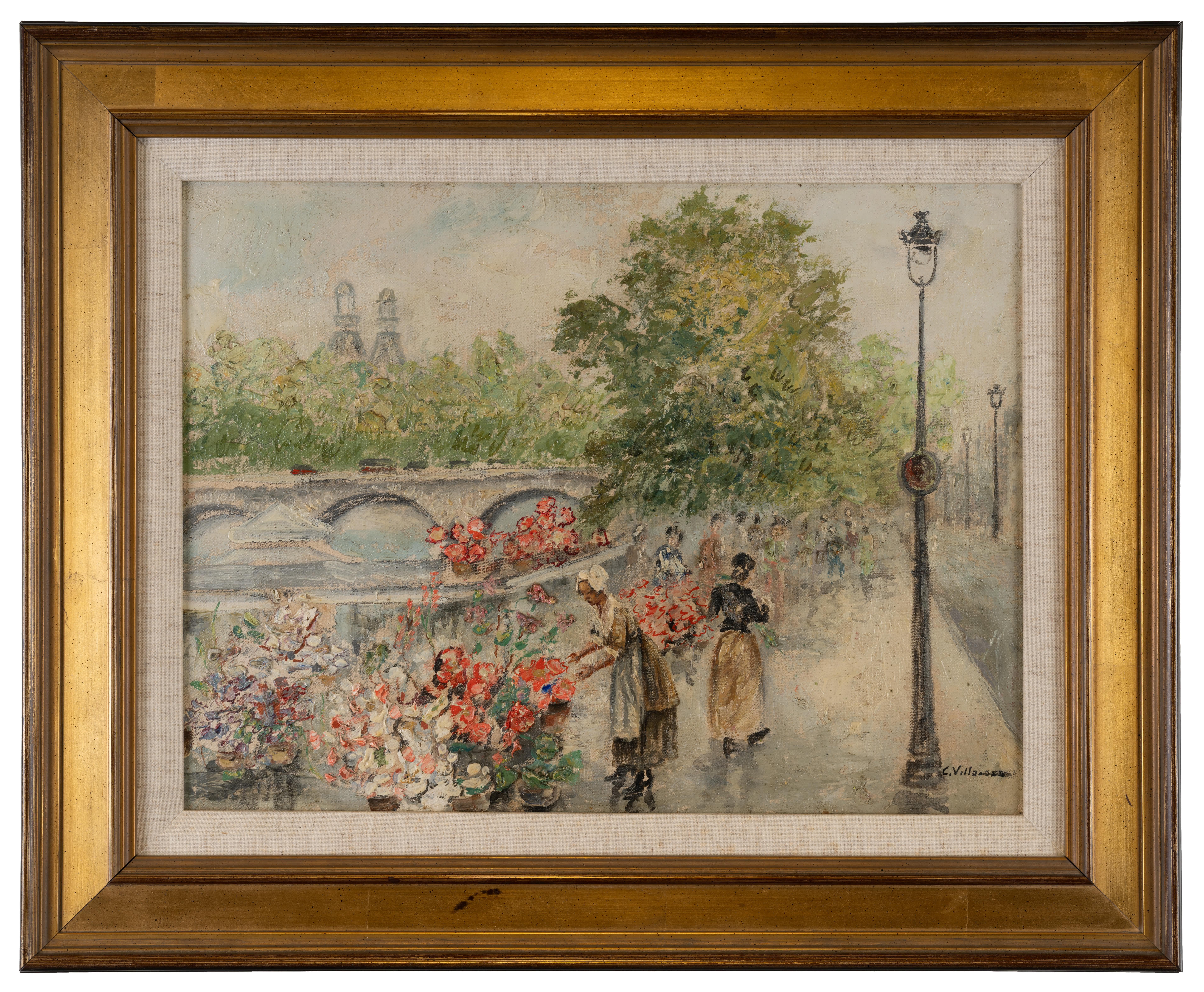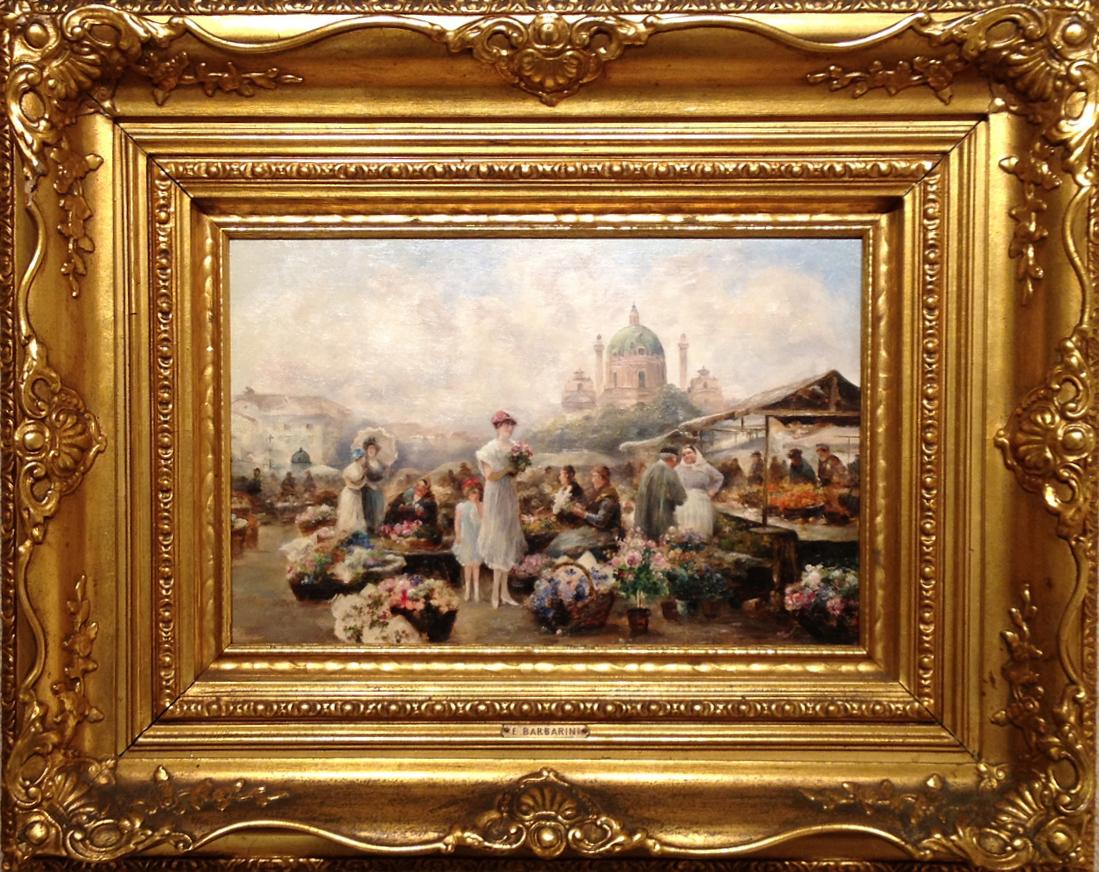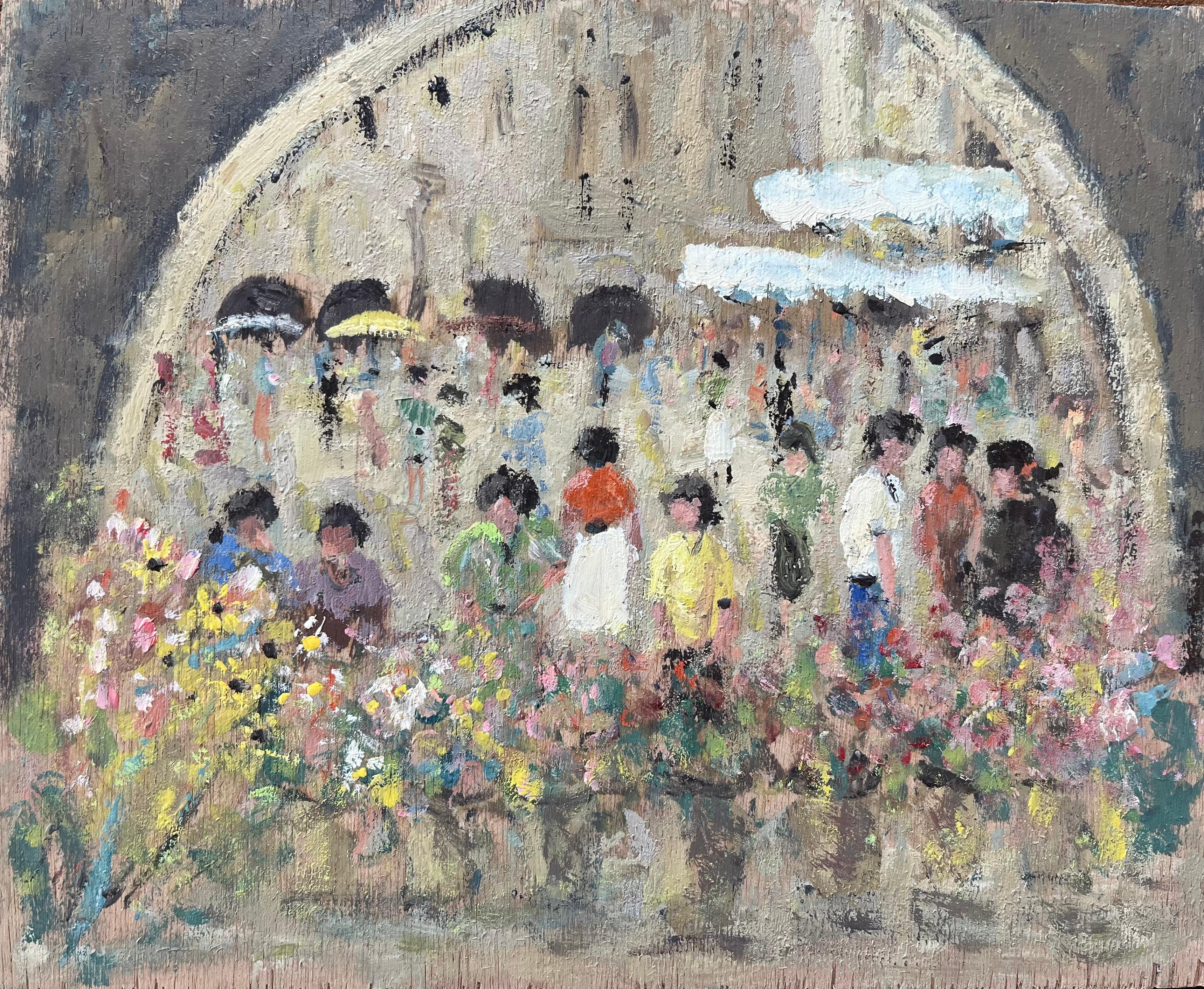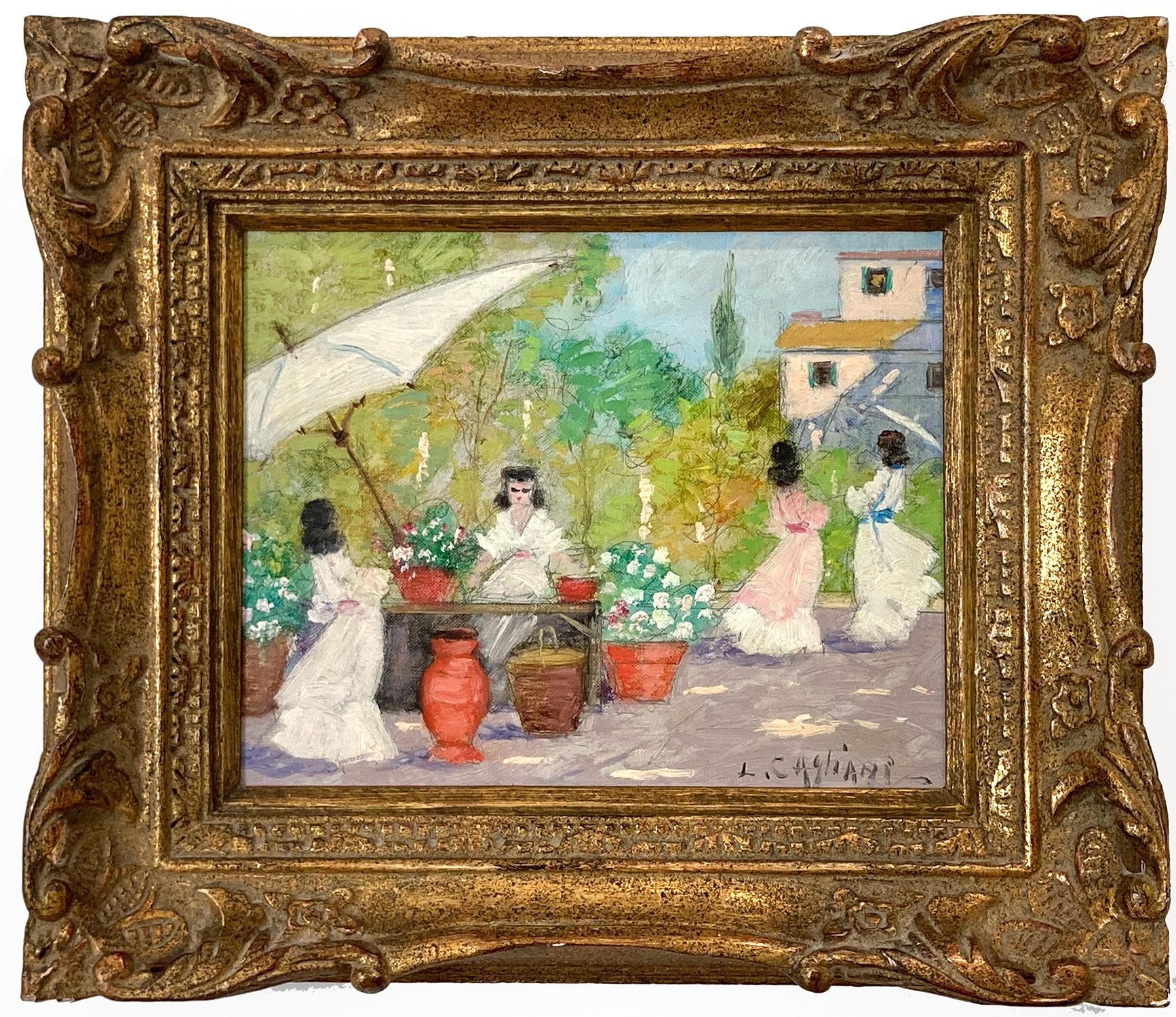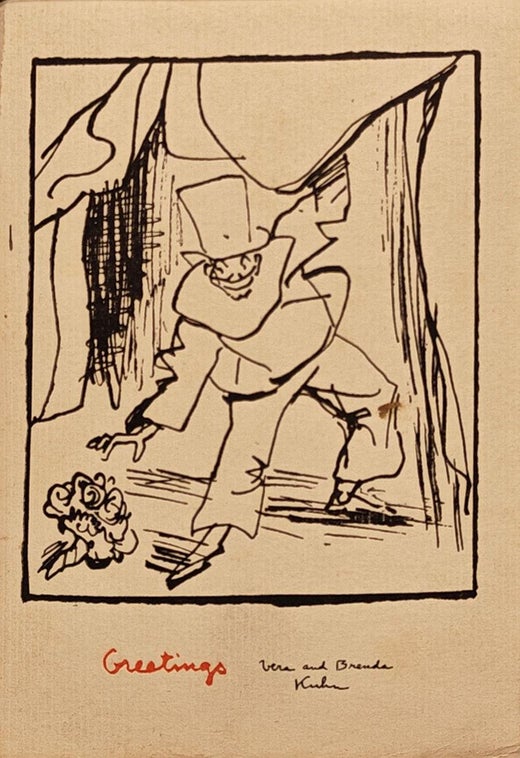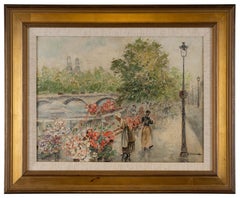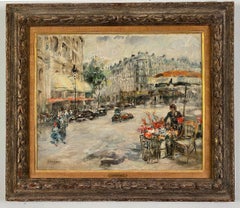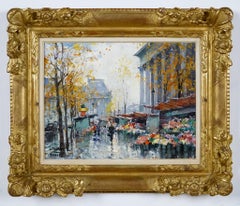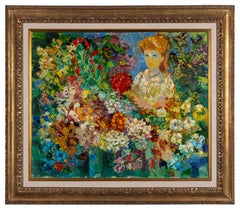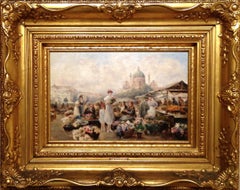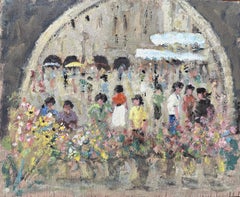Items Similar to At the Flower Market
Want more images or videos?
Request additional images or videos from the seller
1 of 9
Walt KuhnAt the Flower Market
$30,000
£22,661.66
€26,190.42
CA$42,158.08
A$46,872.47
CHF 24,681.20
MX$568,704.06
NOK 312,476.03
SEK 292,088.93
DKK 195,448.08
About the Item
Walt Francis Kuhn
American, 1877-1949
At the Flower Market
Oil on Canvas
15 by 18 in, w/ frame 22 ½ by 25 ½ in
Signed lower right
A painter and major organizer of the Armory Show, Walt Kuhn is perhaps best known for his circus figure-clown depictions. They were unique in that he treated his subjects as human beings conditioned to specialized jobs. He also painted still lifes and some landscapes. He was inspired and influenced by many artists, most notably Paul Cezanne, and like Cezanne, he destroyed many of his canvases, saving only about a dozen paintings a year.
He was born in Brooklyn, New York in 1877 (some older sources quote 1880 as his year of birth) with the name William, but in 1900 first used the name "Walt" when illustrating magazines in San Francisco. He studied at the Royal Academy in Munich from 1901 to 1903, and returned to New York where he worked as a cartoonist and magazine illustrator.
He was associated with "The Eight", New York modernist painters, and with Arthur B. Davies, was a the key figure in forming the American Association of painters and Sculptors that organized the Armory Show of 1913 that introduced modernist European art to America. Kuhn was executive secretary of the Association and traveled abroad to select entries for the Armory Show.
In 1941, he was granted a press pass to all of the Madison Square Garden performances of the Ringling Brothers Circus, which reinforced his focus on that subject matter.
He also had a major interest in the American West, and between 1918 and 1920 did 29 paintings in a series he called Imaginary History of the West, whose source material was primarily books. In 1936 and 1937, he was commissioned by the Union Pacific Railroad to design the interior of two club cars, The Frontier Shack and Little Nuggett.
Exhibited:
Beaux Arts Gallery (SF), 1928; SFAA, 1930. In: Brooklyn Museum; Cincinnati Museum; Detroit Inst. of Arts; LACMA; MM; AIC; Boston Museum; MOMA; Whitney Museum (NYC).
- Creator:Walt Kuhn (1877-1949, American)
- Dimensions:Height: 22.5 in (57.15 cm)Width: 25.5 in (64.77 cm)
- More Editions & Sizes:22 ½ by 25 ½ inPrice: $30,000
- Medium:
- Movement & Style:
- Period:
- Condition:
- Gallery Location:Sheffield, MA
- Reference Number:Seller: 012421stDibs: LU700315880692
Walt Kuhn
Walt Kuhn (1877-1949) He was associated with "The Eight" and with Arthur B. Davies, was a the key figure in forming the American Association of painters and Sculptors that organized the Armory Show of 1913 that introduced modernist European art to America. Kuhn was executive secretary of the Association and traveled abroad to select entries for the Armory Show. He was strongly influenced by Cezanne which is evident in many of his paintings. Like Cezanne, he destroyed many of his paintings, keeping only about a dozen a year. He was born in Brooklyn, New York and in 1900 first used the name Walt when illustrating magazines in San Francisco. He studied at the Royal Academy in Munich from 1901 to 1903 and returned to New York where he worked as a cartoonist and magazine illustrator. In the permanent collection of most major museums worldwide. His record price for a painting to date is 1.6 Million dollars.
About the Seller
4.3
Vetted Professional Seller
Every seller passes strict standards for authenticity and reliability
1stDibs seller since 2017
55 sales on 1stDibs
Typical response time: 12 hours
- ShippingRetrieving quote...Shipping from: Sheffield, MA
- Return Policy
Authenticity Guarantee
In the unlikely event there’s an issue with an item’s authenticity, contact us within 1 year for a full refund. DetailsMoney-Back Guarantee
If your item is not as described, is damaged in transit, or does not arrive, contact us within 7 days for a full refund. Details24-Hour Cancellation
You have a 24-hour grace period in which to reconsider your purchase, with no questions asked.Vetted Professional Sellers
Our world-class sellers must adhere to strict standards for service and quality, maintaining the integrity of our listings.Price-Match Guarantee
If you find that a seller listed the same item for a lower price elsewhere, we’ll match it.Trusted Global Delivery
Our best-in-class carrier network provides specialized shipping options worldwide, including custom delivery.More From This Seller
View AllFlower Market in Paris
By Cesar A. Villacres
Located in Sheffield, MA
Cesar Villacres
Ecuador, 1880–1941
Flower Market in Paris
Oil on board
12 by 16 in, w/ frame 17 ¼ by 21 in
Signed lower right
Cesar Villacres was an Ecuadorian artist...
Category
Early 20th Century Impressionist Paintings
Materials
Oil
Flower Seller, Paris
Located in Sheffield, MA
Cesar Villacres
Ecuador, 1880–1941
Flower Seller, Paris
Cesar Villacres was an Ecuadorean artsit that worked in South America & Paris.
He exhibited i...
Category
1930s Post-Impressionist Landscape Paintings
Materials
Oil
Marche de Fleurs, a La Madeleine Paris 1954
By Jean Salabet
Located in Sheffield, MA
Jean Salabet
French, 20th Century
Marche de Fleurs, La Madeleine Paris
Jean Salabet was a School of Paris painter know for his colorful Parisia...
Category
1950s Post-Impressionist Landscape Paintings
Materials
Oil
Marchande de Fleurs
By Emilio Grau Sala
Located in Sheffield, MA
Emilio Grau-Sala
Spanish, 1911-1975
Marchande de Fleurs
Oil on Canvas
23 ¾ by 29 in, w/ frame 32 ½ by 37 ½ in
Signed lower left
Son of the draughtsman Juan Grau Miró, Grau Sala com...
Category
Mid-20th Century Fauvist Paintings
Materials
Oil
Still Life with Bouquet of Flowers
Located in Sheffield, MA
Emanuele Cappello
Italian, born 1936
Still Life with Bouquet of Flowers
Oil on canvas
19 ½ by 27 ½ in, w/ frame 28 ¼ by 36 ¼ in
Signed lower right
Category
Late 20th Century Impressionist Still-life Paintings
Materials
Oil
Marche De Fleurs, Paris
By Jean Salabet
Located in Sheffield, MA
Jean Salabet
French, Born 1900
Marche De Fleurs, Paris
Oil on canvas
20 by 24 in, w/ frame 25 ¼ by 29 ½ in
Signed lower left
Jean Salabet was a School of Paris painter known for hi...
Category
Mid-20th Century Impressionist Landscape Paintings
Materials
Oil
You May Also Like
Vintage Oil Painting - Flower Market
By Raymond Bailly
Located in Houston, TX
Eye catching oil on paper of an outdoor flower market brimming with colorful blooms by French artist Raymond Bailly, circa 1970.
Original one-of-a-kind artwork on paper displayed on...
Category
1970s Landscape Paintings
Materials
Paper, Oil
Vienna Flower Market oil painting by Emil Barbarini
Located in Hudson, NY
Painting measures 10 ½" x 16" and framed 20 ½" x 26" x 4"
Category
1920s Impressionist Landscape Paintings
Materials
Oil, Panel
French Impressionist Oil Painting of a Bustling Flower Market with Figures
By Fanch Lel
Located in Cirencester, Gloucestershire
Title: French Impressionist Oil Painting of a Bustling Flower Market with Figures
By Fanch Lel (French b. 1930)
Size: 8.75 x 10.75 inches (height x width)
Oil painting on board, unfr...
Category
20th Century Impressionist Landscape Paintings
Materials
Oil
1990 Oil - The Market
Located in Corsham, GB
Signed illegibly and dated to the lower right. Presented in a gilt frame with a cotton slip. On canvas.
Category
20th Century Figurative Paintings
Materials
Oil
$404 Sale Price
20% Off
"Parisian Flower Market" Romantic Impressionist Oil Painting with Figures
By Luigi Cagliani
Located in New York, NY
A whimsical oil painting depicting a Parisian Flower Market scene in Paris, France by Luigi Cagliani. As an Italian Impressionist artist Cagliani most of his works were produced in t...
Category
Early 20th Century Impressionist Landscape Paintings
Materials
Canvas, Oil
Modernist Oil Painting George Schwacha Brooklyn Street Scene Fruit Market WPA
By George Schwacha Jr
Located in Surfside, FL
Hand signed lower left corner
Oil on masonite
Dimensions: Frame H 18.25" x W 22.25". Sight H 11.25" x W 15.25
This is a great scene, vintage Americana. Possibly Crown Heights in Brooklyn New York City. Done in a mid century modern style with great vibrant colors and loose, adept, brushwork. Fruit vendor with ladies shopping.
George Schwacha, Jr. (1908 - 1986) New Jersey artist.
Known for Landscape painting and snow scenes. He studied Arthur W. Woelfle; John Grabach; Edward Dufner and A. Schweider.
George Schwacha was president of the American Artists Professional League and a past president of the Audubon Artists and Art Center of New Jersey. He belongs to the American Watercolor Society, The National Society of Painters in Casein, and the Philadelphia Watercolor Club. His paintings have been shown throughout the country at museums such as the Pennsylvania Academy, the Corcoran Gallery in Washington, DC and the Birmingham Art Museum, The Butler Art Institute in Youngstown, Ohio the Connecticut Academy of Fine Arts, as well as in leading New Jersey and New York exhibitions, including the American Society of Arts and Letters. He is listed in Who's Who in American Art and International Directory of Arts.
His work is represented nationally in over 30 museums and public collections including the Newark Museum, Montclair Museum, Birmingham Art Museum, the Isaac Delgado Museum in New Orleans, and the Butler Art Institute. Worldwide he is also represented in collections in the following countries: Austria, Belgium, Canada, Egypt, England, France, Germany, Greece, Holland, Hong Kong, Israel, Scotland and Switzerland.
Seymour Zayon, Bertram Hartman, Hugh Campbell, Frank Herbst, Joseph Newman, Theodore Valenkamph, Robert John McClelland, Nicolai Cikovsky, Ben Benn, George Howell Gay, Robert Brackman, Vernon Wood...
Category
Mid-20th Century American Modern Figurative Paintings
Materials
Masonite, Oil
